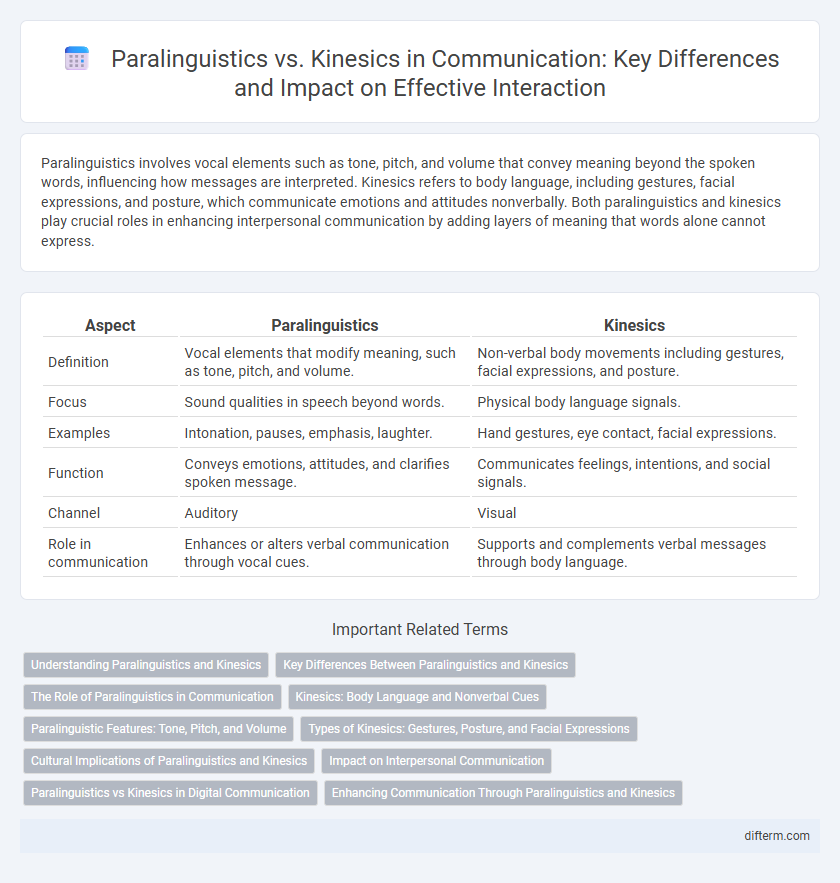Paralinguistics involves vocal elements such as tone, pitch, and volume that convey meaning beyond the spoken words, influencing how messages are interpreted. Kinesics refers to body language, including gestures, facial expressions, and posture, which communicate emotions and attitudes nonverbally. Both paralinguistics and kinesics play crucial roles in enhancing interpersonal communication by adding layers of meaning that words alone cannot express.
Table of Comparison
| Aspect | Paralinguistics | Kinesics |
|---|---|---|
| Definition | Vocal elements that modify meaning, such as tone, pitch, and volume. | Non-verbal body movements including gestures, facial expressions, and posture. |
| Focus | Sound qualities in speech beyond words. | Physical body language signals. |
| Examples | Intonation, pauses, emphasis, laughter. | Hand gestures, eye contact, facial expressions. |
| Function | Conveys emotions, attitudes, and clarifies spoken message. | Communicates feelings, intentions, and social signals. |
| Channel | Auditory | Visual |
| Role in communication | Enhances or alters verbal communication through vocal cues. | Supports and complements verbal messages through body language. |
Understanding Paralinguistics and Kinesics
Paralinguistics involves vocal elements such as tone, pitch, and volume that convey meaning beyond words, playing a crucial role in interpreting emotions and attitudes during communication. Kinesics refers to body language, including gestures, facial expressions, and posture, which provides nonverbal cues that complement or contradict spoken messages. Mastery of both paralinguistics and kinesics enhances effective communication by allowing individuals to interpret underlying intentions and emotional states accurately.
Key Differences Between Paralinguistics and Kinesics
Paralinguistics refers to the vocal elements of communication such as tone, pitch, volume, and speech rate, which convey emotions and meaning beyond the spoken words. Kinesics involves non-verbal body language, including gestures, facial expressions, posture, and eye contact, which communicate attitudes and feelings without vocalization. The key difference lies in paralinguistics focusing on vocal nuances while kinesics centers on physical body movements as separate channels of non-verbal communication.
The Role of Paralinguistics in Communication
Paralinguistics plays a crucial role in communication by conveying emotions and intentions through vocal elements such as tone, pitch, volume, and speech rate, which enrich the message beyond words. These vocal cues help interpret the speaker's attitude, emphasize meaning, and regulate conversational flow, thereby enhancing interpersonal understanding. Unlike kinesics, which relies on body language and gestures, paralinguistics exclusively focuses on voice-related signals that shape the effectiveness of spoken communication.
Kinesics: Body Language and Nonverbal Cues
Kinesics, the study of body language and nonverbal cues, plays a crucial role in communication by conveying emotions and intentions without spoken words. Facial expressions, gestures, posture, and eye contact are key elements that reveal subconscious messages and influence interpersonal interactions. Understanding kinesics enhances the ability to interpret unspoken signals, improving clarity and empathy in both personal and professional communication.
Paralinguistic Features: Tone, Pitch, and Volume
Paralinguistic features such as tone, pitch, and volume significantly influence the interpretation of spoken messages by conveying emotions and attitudes beyond words. Variations in tone can indicate sarcasm or sincerity, while pitch changes may reflect questions or emphasis, and volume adjustments often signal urgency or confidence. These vocal elements complement kinesics, the study of body language, by enriching communication through auditory cues that shape listener perception and response.
Types of Kinesics: Gestures, Posture, and Facial Expressions
Kinesics encompasses nonverbal communication through body language, including gestures, posture, and facial expressions, each conveying distinct emotional and social signals. Gestures, such as hand movements or nodding, supplement or replace verbal messages, while posture reveals attitudes and feelings, reflecting confidence or submission. Facial expressions universally express emotions like happiness, anger, or surprise, playing a crucial role in face-to-face interactions and enhancing communicative clarity.
Cultural Implications of Paralinguistics and Kinesics
Paralinguistics and kinesics carry distinct cultural implications that influence how messages are interpreted across different societies. Variations in vocal tone, pitch, and pauses in paralinguistics can signal respect, aggression, or sarcasm, depending on cultural norms, while kinesics such as gestures, facial expressions, and posture hold culturally specific meanings that may be misconstrued if misinterpreted. Understanding these cultural nuances is crucial for effective intercultural communication, reducing misunderstandings and enhancing relational dynamics.
Impact on Interpersonal Communication
Paralinguistics, including tone, pitch, and volume of voice, significantly shape interpersonal communication by conveying emotions and attitudes beyond spoken words. Kinesics, which involves body language such as facial expressions, gestures, and posture, impacts the clarity and effectiveness of interactions by providing nonverbal cues that support or contradict verbal messages. Both paralinguistics and kinesics are essential for interpreting intent, building rapport, and enhancing understanding in face-to-face communication.
Paralinguistics vs Kinesics in Digital Communication
Paralinguistics in digital communication refers to vocal elements such as tone, pitch, and pace conveyed through audio messages or voice notes, enhancing emotional nuance and intent. Kinesics, involving body language and facial expressions, is limited in digital communication unless video platforms are used, where gestures and posture become visible cues. Effective digital communication often relies on combining paralinguistic signals with kinesics via video calls to improve clarity and interpersonal connection.
Enhancing Communication Through Paralinguistics and Kinesics
Paralinguistics and kinesics play vital roles in enhancing communication by conveying emotions and intentions beyond spoken words. Paralinguistics involves vocal elements such as tone, pitch, and volume that help clarify meaning and express feelings, while kinesics includes body language, facial expressions, and gestures that provide visual cues for understanding. Mastering both paralinguistic signals and kinesic behaviors improves interpersonal interactions, reduces misunderstandings, and fosters stronger connections.
paralinguistics vs kinesics Infographic

 difterm.com
difterm.com